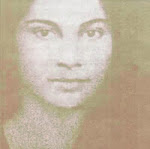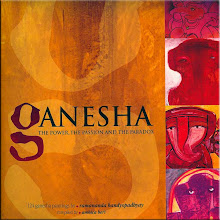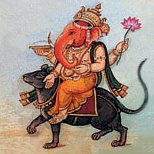Saturday, December 17, 2011
Wednesday, November 9, 2011
Thursday, October 27, 2011
Wednesday, October 12, 2011
Thursday, September 22, 2011
Sunday, September 18, 2011
Thursday, September 1, 2011
Wednesday, August 24, 2011
Shri Ganesha Chaturthi 2011
Just a reminder that Ganesha Chaturthi (a special day to worship Shri Ganesha on the fourth day of the waxing phase of the moon) falls on Thursday the 1st of September this year.
Fond of Pomegranates
One of the Sanskrit names of Shri Ganesha is Bijapuraphalasakta; literally: "fond of the many-seeded fruit". The Bijapuraphala is the pomegranate.
Since ancient times this fruit, which originated in Eastern Iran, has been associated with fertility and abundance because of its many seeds.
In Greece there is a tradition of bringing a pomegranate as a gift when visiting people who have moved into a new home. The pomegranate is placed as an offering near the Greek Orthodox icons in the house to invoke blessings from the Divine for the new occupants. Pomegranates are also broken on the ground by the Greeks as an offering to bring luck at a marriage celebration.
The fruit appears in many depictions of the Virgin Mary and Jesus as a symbol of their sacrifice, which has given abundance to mankind.
In recent times the fruit has become a kind of superfood, with many health benefits claimed for it. Pomegranate juice is proliferating on supermarket shelves, and it is almost seen as a fountain of youth.
In Indian traditional medicine (Ayurveda), all parts of the fruit and tree are used to treat various diseases.
In Indian traditional medicine (Ayurveda), all parts of the fruit and tree are used to treat various diseases.
Infant Jesus with pomegranate, Sandro Botticelli.
Monday, August 8, 2011
Brass Statue
This large brass statue, weighing 100kg, is beautifully detailed and proportioned. The seller describes the seating posture of Shri Ganesha in this image as Simhasana (Lion Posture ).
).
 ).
).Friday, August 5, 2011
Wednesday, June 29, 2011
Tuesday, June 14, 2011
Riding on a peacock or swan
terracotta figurine.
Shri Ganesha resides in the Mooladhara Chakra, consisting of the earth element. This chakra is normally a coral or terracotta red colour.
Shri Ganesha resides in the Mooladhara Chakra, consisting of the earth element. This chakra is normally a coral or terracotta red colour.
Sunday, June 5, 2011
Wednesday, May 4, 2011
Wednesday, April 6, 2011
In a Paisley
The Paisley motif (also called boteh) is an auspicious symbol of the Goddess.
Here the artist has shown Shri Ganesha in the womb of the Goddess.
Thursday, March 31, 2011
Dynamic Viewing
I just found out about the dynamic viewing feature introduced by Blogger. You just type the word "view"
at the end of the URL in the address bar above and then the blog appears with a drop down menu offering different ways of seeing the posts, including a mosaic or flip cards of thumbnail images from the whole site. This sure beats going through the whole blog page by page to browse the images. Try it.
Dynamic viewing may not be supported by older web browsers.
Dynamic viewing may not be supported by older web browsers.
Saturday, March 26, 2011
Saturday, March 19, 2011
Three Heads
Trimukha (three-faces) Ganapati, symbolises that Lord Ganesha pervades and transcends the three states of being: past, present and future; corresponding to the three gunas (channels) of existence: tamas, sattva and rajas.
When human beings dwell in the past or future (tamas and rajas) they live in illusion, but true being (sattva) resides in the present moment. Tamas leads to emotionalism, inertia and conditioning; rajas leads to egoism and domination of others; but sattva is conducive to Self-realisation.
Wednesday, March 9, 2011
Wednesday, February 23, 2011
Sunday, February 20, 2011
Durva Grass
Shri Ganesha is often worshipped with ‘durva’ grass (Cynodon dactylon). According to Hindu mythology, Shri Ganesha once defeated a fire-emitting demon by assuming an immense form and swallowing his opponent, but so fiery was the demon’s body that Shri Ganesha started to overheat inside. A group of sages passing by offered a bunch of cooling durva grass. When the grass was placed over his head, Shri Ganesha experienced instant relief from the heat within him. Ever since, durva has been used to worship Ganesha. The tender new tips, with three or five blades, are offered after being dipped in water. 21 tips can be offered.
According to Ayurveda, the traditional medicinal lore of India, durva has powerful healing and purifying properties. Studies at the University of Allahabad in India, found that it has antimicrobial and antiviral properties, and may be useful for the treatment of urinary tract infections, prostatitis, syphilis, and dysentery. Shri Ganesha rules the Mooladhara Chakra, the subtle centre which maintains the reproductive organs and urinary tract.
Cynodon dactylon is native to India and Australia. In Australia it is called couch (pronounced 'kooch'), and is used for lawns.
Photos from The University of Queensland, Australia, website
Cynodon dactylon is native to India and Australia. In Australia it is called couch (pronounced 'kooch'), and is used for lawns.
Photos from The University of Queensland, Australia, website
Sunday, February 6, 2011
Happy Ganesha Jayanti
Shri Ganesha Jayanti is the celebration of the birthday of Lord Ganesha.
wikipedia entry on Ganesh Jayanti
wikipedia entry on Ganesh Jayanti
Saturday, January 22, 2011
Subscribe to:
Comments (Atom)






































